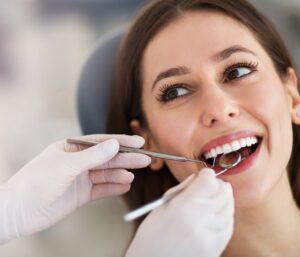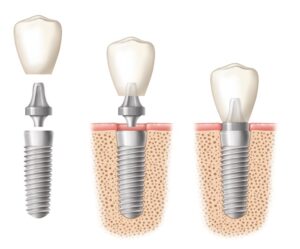Header logo
header top contact widget
Oral Sedation
Afraid Of The Dentist? Let’s Help You Get Past That For A Healthy Smile!
Posted on Jul 22, 2020 by William J. Claiborne, DDS MS
By some estimates, having a fear of dental visits affects over 70 percent of American adults. When people are afraid of going to the dentist, many often do not receive the regular care necessary to maintain a healthy smile.
As an Asheville Periodontist, I find that the origin of many who develop periodontal (gum) disease is from fear associated with dental visits. It is not unusual for a fearful dental patient to avoid going to the dentist for years, only ‘giving in’ when something becomes so painful they can no longer delay treatment.
We know that when it comes to dental fear, different people have different levels. Some patients are very relaxed in our office from the moment they walk in and throughout treatment. Others are fine until they are seated in the treatment chair. Still, others are anxious throughout their visit.
A study published by the Dental Research Journal revealed nearly 59 percent of 473 adult participants had dental fears. The study included males and females of varying ages and education levels. Although females presented a higher likelihood for dental fear, there was very little difference elsewhere. What did stand out, however, was how many had experienced traumatic dental episodes.
Unfortunately, a traumatic experience in a dental chair with a too-rough dentist tends to remain in the subconscious forever. Many fears are the result of a frightful experience as a child, feeling helpless and afraid. Such an experience tends to make an indelible mark on the subconscious and resurface whenever a dentist or dental office comes to mind.
If you experience these feelings associated with dental visits, there is nothing ‘wrong’ with you. However, delays in care can allow small problems to become more complex, requiring more involved treatment.
Many high-fear patients only force themselves into a dental chair when they are in such pain that they have no choice. It is far easier for adults to find a way to have regular exams and cleanings to prevent emergency needs. This begins by finding the right dental office.
Until then, regular dental check-ups are something that can’t be duplicated at home. Even a thorough, daily brushing and flossing routine misses bacteria on occasion. Within the course of just 48 hours, oral bacteria can form a cement-hard colony attached to tooth surfaces. This accumulation of bacteria eats away at tooth enamel and gum tissues.
As oral bacteria consume gum tissues, inflammation begins. This is gingivitis, the initial stage of gum disease. In this, the gums are tender and occasionally bleed when brushing. As gingivitis progresses to periodontal disease, symptoms include persistent bad breath and gums that turn red versus a healthy pink color. Gum tissues may begin to recede, exposing sensitive areas of tooth roots.
Eventually, the infectious bacteria will attack further beneath the gum line. This inflammation leads to damage to the bone structures that support tooth roots. Pus pockets may form on gums and teeth may loosen. To no surprise, periodontal disease is the nation’s leading cause of adult tooth loss.
This infectious bacteria doesn’t just remain in the mouth. Through tears in weakened gum tissues, it can enter the bloodstream. It’s presence can trigger inflammatory reactions that have been linked to heart disease, stroke, some cancers, preterm babies, arthritis, diabetes, erectile dysfunction (ED), and impotency. Some studies are showing a correlation to Alzheimer’s disease.
What we often find with high-fear patients is their assumption that good at-home care can take the place of their regular care visits. However, even a diligent home-care routine leaves them susceptible to oral bacteria. A number of factors heighten vulnerability to bacterial accumulation, including dry mouth and diet.
Dry mouth occurs due to a wide range of factors. Some medications have a drying affect on the mouth. Certain foods and beverages contribute to dry mouth, especially those containing caffeine and alcohol. Smoking is very drying to oral tissues. And, the aging process leaves us with drier mouths.
Eating sugary foods and many carbohydrates are just as detrimental to oral health. Many Americans snack during the day, often on chips, crackers and candy bars – which are then washed down with sugary sodas. All this converts into a sugar based super-food in the mouth that provides oral bacteria with sustenance that super charges their reproduction.
How does a fearful adult overcome the problem so they can have the dental care they need?
In our office, patient comfort is a priority at every visit. We have even designed our reception area to pamper you from the moment you enter. Patients in this area can enjoy a selection of gourmet coffees, cable television and WIFI connection. The seating is comfortable and our front office staff are attentive to your needs.
We offer a private consultation room for patients as well. In this room, we can discuss treatment and answer questions in a comfortable setting. This allows patients to become better informed about their treatment needs and options versus communicating while they are seated in a treatment chair.
Our surgical suite offers a rather unique setting for a periodontal office. A large window provides beautiful mountain views, very soothing to our patients. In addition, we offer oral sedation as well as I.V. sedation (twilight sleep) for most procedures, if desired.
Oral sedation is a pill that helps patients relax. It also has an amnesiac effect, leaving most with little or no memory of treatment afterward. I.V. sedation places the patient in a deeper sedative state, also erasing memory of the procedure. It is administered by a doctor of anesthesiology for optimal comfort and safety. With both, patients are monitored with advanced safety equipment throughout treatment.
Our patients also find our entire staff is a unified team who reflect sincere compassion and commitment to exceptional, comfortable care. While the doctors involved in your care are all top-notch, I must admit that our staff are the pros at making our patients feel truly pampered.
When patients realize that our goal is to provide exceptional care and comfort, most relax. This creates a sense of trust that causes many to no longer perceive dental care as dreaded, frightening events. Once the obstacle of fear is replaced with feelings of trust, the process to achieve a healthy, confident smile becomes a much easier one.
If you or someone you know has fear that has prevented dental care, the possibility of gum disease is pretty high. We suggest beginning with a consultation appointment, which occurs in our private consultation room. This is removed from the clinical area and provides a relaxed setting where patients can share their unique needs and concerns.
Call 828-274-9440 to schedule or learn more. I’m sure you’ll find our friendly telephone staff is welcoming and reassuring from the very first conversation.
We Are Seeing Patients Again With New Appointment Protocols
Posted on May 20, 2020 by William J. Claiborne, DDS MS
Lately, when people see a hospital worker on television news, healthcare workers have on layers of garb that we’re unaccustomed to seeing. Hopefully, in time, all this protective layering won’t be needed. For now, it’s in line with proper precautions for the safety of both patients and staff.

We are seeing patients again!
As established periodontists in Asheville, it has been a pleasure for Dr. Boyland and I to be able to open our doors again for patient care. And, our schedule is full! Patients in need of treatment have been patiently (but anxiously) waiting to resume periodontal therapy and dental implant placement.
However, our reopening brings some new protocols in addition to our already-stringent infection-control measures. Some new steps that patients may notice now in the flow of the appointment, from the check-in process to check-out. Too, patients will see us attired in more layers than before.
As a heads up, our doctors and staff are wearing protective equipment (N95 masks, gowns, face shields, etc.). This protective gear does not interfere with patient communication nor the exceptional care we have always provided.
Other than our “new look,” however, patients will also go through a few new steps, which include:
- Once patients arrive for scheduled appointments, they are asked to call our main number (828-274-9440) from their vehicles. Our receptionist will provide the patient with a pre-appointment questionnaire.
- After we retrieve the completed form, a staff member will escort the patient into the office. (For now, only appointed patients are allowed unless accompanying a child or disabled patient.)
- Once inside, patients will have their temperature taken and a staff member will escort them to a treatment suite.
- After care is completed, a staff member will walk the patient to our check-out desk.
In addition, patients can have the peace of mind that our Asheville periodontal office has always adhered to the highest standards of infection control in dentistry. Typical steps that have always been in place include are the sterilization process used on the instruments used in patient care (such as probes).
These pieces are heat sterilized at high temperatures for up to 40 minutes, killing bacteria, viruses and infectious micro-organisms. Once sterile, the instruments are carefully packaged until ready to unwrap for use in the treatment room.
Even the water used (for rinsing or as a spray to manage air particles) comes through water lines that undergo a special “flushing” process. This cleansing process dislodges and eliminates biofilm that can occur when minuscule particles attach to the interior of these lines. Thus, the water sprayed in your mouth during certain procedures is delivered so bacteria levels are at such a low point they are virtually non-existent.
After each patient is seen, treatment chairs, lighting, and any equipment the patient or staff come in contact with are thoroughly wiped down.
These steps have always been done to ensure the safety and well-being of our patients as well as our doctors and staff. Yet, now more than ever, we have a unique mindset in everything we do.
While the vast majority of patients seen feel very comfortable in our office and infection control steps being taken, we encourage questions or concerns so we can explain, reassure or even reschedule those who are still uneasy about close contact. Just call us at 828-274-9440. Our friendly front staff will be happy to assist you.
What’s most important is that you stay safe while keeping your oral health at its best. The progression from poor oral hygiene to gingivitis to full-blown periodontal disease is faster than many people realize.
Be sure to brush at least twice a day for at least minutes per brushing. Brush your tongue with your toothbrush once a day (especially towards the back where most bacteria hide out) and floss daily. Keep your mouth moist and limit sugar. Use an oral rinse that contains no alcohol as an added measure to minimize oral bacterial buildup.
Let’s all emerge from this odd time in our history with smiles that are healthy, accompanied by hugs!
The 1-2-3’s Of Dental Implants
Posted on Apr 29, 2020 by William J. Claiborne, DDS MS
Over time, certain things are often referred to in catchphrases that simplify what is being described. For example, “Kleenex” is actually a brand name that refers to tissues. “Clorox” is commonly used as a generic for bleach, even though it’s a specific brand. And, “Uber” has become a way to describe a paid means of auto transportation, even if a taxi or Lyft is being used.
This is why the term “dental implant” may be confusing to some people. This implies the replacement of a missing tooth or teeth with a base that is implanted into the jaw bone. However, to be clear, a dental implant is not an entire structure. Let’s look at the various components of a complete dental implant system. 
Although there are different types of implant systems (designed to accommodate specific needs), all work in in a similar fashion. The actual “implant” is a hollow, screw-like cylinder. This is the portion that is actually “implanted” in the jaw bone at a strategic angle and depth.
Once placed, the implant is covered over with gum tissue. For several months after, the implant goes through a process known as “osseointegration.” In this, the bone grows around the implanted portion, which secure it in place. This restores the foundation like that of natural teeth for dependable and comfortable biting and chewing stability.
This stage, often referred to as the “healing” process, typically takes several months. However, a denture or temporary can be worn comfortably so going without teeth is not a worry.
Once healing is complete, a post is secured inside the hollow core of the implant. This post will support your final replacement tooth or teeth. Most replacement teeth are made of porcelain, which provides the most durable of all materials used in dental restorations.
Porcelain is an ideal material for replacement teeth. It is less resistant to stains and provides an exceptionally natural look and feel, even reflecting light as a natural tooth.
A successful outcome in any Dental Implant treatment begins with the selection and placement process. A Periodontist has specialized training in the diagnosis and placement of all types of implant systems. This means the implant system recommended for you will be the type most suited to your individual needs and goals.
An important aspect of implant success also relies on the assessment of bone mass. When the upper or lower jaw has insufficient bone to support the implant being placed, there is a risk of failure. This can occur in implants placed too close to the sinus cavity (for upper implants) or a nerve that runs through the mandible (lower jaw).
Too, an implant requires careful selection and placement in order to adequately support the replacement teeth being attached. In some cases, as few as 4 – 6 implants can support a complete arch of teeth. This decision is best left in the hands of a periodontal specialist.
In cases of severe bone loss, a periodontist can also perform bone rebuilding procedures prior to implant placement. This is sometimes through bone grafting but most commonly the application of a bone-rebuilding material. Additionally, some implant systems, such as the “All On 4” utilize unique angles to provide support in minimal bone depth with no bone rebuilding necessary.
The best implant system for you can be determined after an examination. During this time, I can discuss options best for you and explain the process. Call 828-274-9440 to schedule an appointment. Or, ask to begin with a Consultation.
We also encourage you to share any concerns about comfort options or treatment fees. Many people avoid looking into dental implant treatment because they are afraid of the procedure or fear they cannot manage the fees. Rather than assume these are obstacles, share your concerns so we can address them head on!
Be In-The-Know To Avoid Cavities, Gum Disease
Posted on Apr 02, 2020 by William J. Claiborne, DDS MS
During this highly unusual time, people are relying on the internet for communication (work and social), information, and entertainment. Computers, tablets and smart phones are keeping us connected as we ‘shelter in place’ until this global pandemic is under control.
A lot of Americans are using their “stuck inside” time to expand their minds. Whether it’s to enjoy an audio book, watch PBS specials, or learn how to do something on YouTube, using the time positively is helping people avoid getting mired down in worry and anxiety.
 As a periodontal specialist in Asheville, NC, I hope adults will use some of their time to become more aware of the hazards of gum disease. The damage that periodontal disease (‘perio’) can have far reaching consequences, affecting the health inside and mouth and overall health, as I’ll explain.
As a periodontal specialist in Asheville, NC, I hope adults will use some of their time to become more aware of the hazards of gum disease. The damage that periodontal disease (‘perio’) can have far reaching consequences, affecting the health inside and mouth and overall health, as I’ll explain.
People are often surprised to hear that they have developed gum disease since it is often without obvious symptoms in early stages. Once it’s fully underway, however, many people ignore the warning signs or assume they’ll “go away”.
In my dental specialty, I believe that by keeping Americans informed of how the progression of gum disease occurs could help to greatly reduce the extent of this disease, which plaques over 47 percent of adults.
Let’s begin by looking at the process of gum disease:
• Oral Bacteria: The mouth is a warm, dark and moist environment — perfect for harboring bacteria. The mouth is the first point of contact for a large extent of the bacteria that enters the body. Bacteria is on food, utensils, lip gloss and even your tooth brush. All mouths have bacteria, some of it are beneficial. Although bacteria in the mouth are perfectly ‘normal’, the problem begins when too much bacteria accumulate.
• Plaque: Without proper brushing, flossing, saliva flow and diet, oral bacteria can reproduce rapidly. For an example of just how quickly these bacteria accumulate, run your tongue over your teeth after brushing in the morning. They should feel slick and clean. Then, before brushing at bedtime, run your tongue over your teeth again. The accumulation of oral bacteria over the mere course of a day has likely formed a sticky film on teeth. This is known as plaque. This film is actually a coating of bacteria.
• Tartar (or Calculus): In just 48 hours, unremoved plaque can harden into tartar. These ‘chunks’ are colonies of oral bacteria and typically attach to the base of teeth near the gum line. These cement-hard masses can no longer be brushed or flossed away. They must be removed by a dentist or hygienist with special tools. If allowed to remain, like plaque, tartar will continue to multiply as these bacterial colonies feed on tooth enamel and tender gum tissues.
• Gingivitis: This is the first stage of gum disease. At this level, gum tissues are under attack and become sore. They may bleed easily when brushing and you may experience an aching sensation in some areas. Breath odor is stronger, even soon after brushing. At this point, with proper measures, you can restore your gums to a healthy state. However, the window of opportunity to combat gingivitis is brief.
• Periodontal (Gum) Disease: At this stage, the gums are inflamed and tender. They begin to darken in color and the seal of gum tissues surrounding teeth begins to loosen. The breath is persistently bad. As this stage of gum disease worsens, it can lead to severe health risks elsewhere in the body.
• Periodontitis: This is the advanced stage of gum disease. The gums are so tender that eating becomes difficult. Breath odor is putrid, as it reflects the rotting state in your mouth. The gum tissues are highly inflamed. Pus pockets may form on the gums near the base of teeth. Eventually, teeth will loosen as the gum tissues and bone structures that support them are destroyed. Tooth removal at this stage is not uncommon.
To no surprise, gum disease is the nation’s leading cause of adult tooth loss. Yet, it’s one of the most preventable diseases with simple measures.
An even more concerning aspect of gum disease is its ability to enter the bloodstream. Once bloodborne, these infectious bacteria can trigger inflammatory reactions elsewhere in the body. Gum disease bacteria has been linked to heart disease, diabetes, arthritis, stoke, memory loss, preterm babies, impotency, some cancers and even Alzheimer’s disease.
This is why we want you to be aware of the importance of having a healthy mouth. We realize there are financial obstacles for some people. However, most dental and specialty offices offer payment plans, many are interest free with no down payment required.
Some people avoid dental visits because they have anxiety or fears. Dental fear is fairly common, even in America where dental care is so advanced (in most practices). If deep fear or anxiety has prevented you from regular dental visits or having much-need treatment, finding a dentist who is experienced in caring for fearful patients is easier today.
Using advanced technology, such as laser dentistry, cone beam imaging, and other features, we are able to diagnose problems more precisely, which helps to minimize treatment. Many options enhance patient comfort and speed healing time.
For many fearful patients, we also offer oral or IV sedation (“twilight sleep”). We are fully equipped for the safety and comfort of administering sedatives for our patients for treatment in our office. Here, patients know us for our gentle touch and respectful, attentive care for each individual.
Occasionally, I hear a patient relay their impression of tooth loss being “just part of growing older.” That is far from the truth. The human body does ‘break down’ here and there but keeping your teeth for a lifetime is a reasonable expectation with proper measures.
Having healthy gums that support teeth can be achieved with an involved relationship with a dentist and a committed oral hygiene routine at home. With proper care, you can easily enjoy a smile of natural teeth all your life.
Twice daily brushing (at least two minutes per time), daily flossing, drinking ample water and limiting sweets and caffeine are simple ways to keep your mouth healthy between regular dental check-ups and cleanings. And, those 6-month check-ups are important. At this time, any tartar that has accumulated can be removed and signs of early gum disease can be noted.
Losing teeth due to gum disease leads to expensive and lifelong upkeep with crown-&-bridge, partials, full denture or dental implants. These tooth replacement needs can be avoided.
If you are experiencing symptoms of gum disease, call 828-274-9440. If fear is an obstacle to having a healthy, confident smile, begin with a consultation to discuss your needs.
Recent Posts
Categories
Archives
- September 2024
- August 2024
- July 2024
- June 2024
- May 2024
- April 2024
- March 2024
- February 2024
- January 2024
- December 2023
- November 2023
- October 2023
- September 2023
- August 2023
- July 2023
- June 2023
- May 2023
- April 2023
- March 2023
- February 2023
- January 2023
- December 2022
- November 2022
- October 2022
- September 2022
- August 2022
- July 2022
- June 2022
- May 2022
- April 2022
- March 2022
- February 2022
- January 2022
- December 2021
- November 2021
- October 2021
- September 2021
- August 2021
- July 2021
- June 2021
- May 2021
- April 2021
- March 2021
- February 2021
- January 2021
- December 2020
- November 2020
- October 2020
- September 2020
- August 2020
- July 2020
- June 2020
- May 2020
- April 2020
- March 2020
- February 2020
- January 2020
- December 2019
- November 2019
- October 2019
- September 2019
- August 2019
- July 2019
- June 2019
- May 2019
- April 2019
- March 2019
- February 2019
- January 2019
- December 2018
- November 2018
- October 2018
- September 2018
- August 2018
- July 2018
- June 2018
- May 2018
- April 2018
- March 2018
- February 2018
- January 2018
- December 2017
- November 2017
- October 2017
- September 2017
- August 2017
- July 2017
- June 2017
- May 2017
- April 2017
- March 2017
- February 2017
- January 2017
- December 2016
- November 2016
- October 2016
- September 2016
- August 2016
- July 2016
- June 2016
- May 2016
- April 2016
- March 2016
- February 2016
- January 2016
- December 2015
- November 2015
- October 2015
- September 2015
- August 2015
- July 2015
- June 2015
- May 2015
- April 2015
- March 2015
- February 2015
- January 2015
- December 2014
- November 2014
- October 2014
- September 2014
- August 2014
- July 2014
- June 2014
- May 2014
- April 2014
- March 2014
- February 2014
- January 2014
- December 2013
- November 2013
- October 2013
- September 2013
- August 2013
- July 2013
- June 2013
- May 2013
- April 2013
- March 2013
- February 2013
- January 2013
- December 2012
- November 2012
- October 2012
- September 2012
- August 2012
- July 2012
- June 2012


